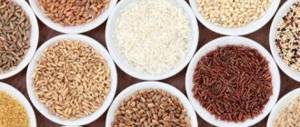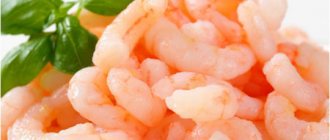What products will buckwheat replace?
The taste and nutritional properties of buckwheat directly depend on the variety and quality of the product itself. Buckwheat goes on sale in four production forms:
- groats - whole, uncrushed grain, cleared of the surface shell;
- prodel (cut) - peeled coarsely chopped grains;
- Smolensk groats - finely ground grains;
- buckwheat flour.
In addition to the usual dark or light brown grains, green (uncooked) buckwheat is gaining popularity. It is considered a healthy and dietary product; it is also used for preparing cereals and other dishes, but it costs two or more times more than regular processed cereals. In terms of usefulness for the body and availability when purchased, the most suitable is considered to be kernel cereal, as an alternative - prodel.
The energy value of whole grain cereals in raw form varies from 308 to 335 kcal. The glycemic index ranges from 50-60 units. During heat treatment, the nutritional value of the product decreases and is:
- 101 kcal/100 g - boiled in water without salt and oil;
- 104 kcal/100g - steamed in hot water.
100 g of whole grain cereal contains:
- proteins - 12.6 g;
- fat - 3.3 g;
- carbohydrates - 57.1 g;
- water - 14 g;
- dietary fiber - 11.3 g.
Porridge made from buckwheat loses 2/3 of the calorie content of the raw product, mainly due to a decrease in carbohydrate content. But the water concentration in the grain increases from 14 g to 75 g.
Buckwheat contains amino-, organic, omega-3 and omega-6 fatty acids and sterols. The carbohydrate component is represented by complex carbohydrates: fiber, starch, glycogen. They are slowly absorbed, smoothly increase blood sugar levels, and provide quick and long-lasting saturation of the body. Buckwheat proteins are superior to all cereal crops in terms of alpha amino acid content. They are characterized by high digestibility - up to 77%.
Vitamin composition includes:
- A (beta-carotene);
- B (thiamine, riboflavin, niacin, choline, pyridoxine, pantothenic and folic acids);
- E (alpha tocopherol);
- N (biotin);
- K (phylloquinone);
- PP (nicotinic acid).
Buckwheat is a valuable source of minerals: silicon, phosphorus, iron, copper, manganese, molybdenum, magnesium, potassium. To a lesser extent, it provides the body with calcium, sodium, sulfur, chlorine, iodine, selenium, fluorine, chromium, and zinc.
One of the most important effects of buckwheat is cleansing the digestive system, ensuring proper functioning of the gastrointestinal tract. A sufficient amount of fiber in the kernel promotes the rapid removal of waste, toxins, and fat breakdown products from the intestines.
Regular consumption of cereals reduces bad cholesterol, blood glucose levels, helps cope with constipation, and prevents the formation of uric acid salts in the kidneys and gall bladder.
Buckwheat is rich in flavonoids, which have a pronounced antibacterial, anti-inflammatory, and antioxidant effect. Starch, present in the grain, acts as an enveloping agent, protects the mucous membranes of the gland from irritating substances, complicates their absorption, and reduces the intensity of painful sensations.
Buckwheat proteins are almost equal in biological value to the proteins of meat and eggs and superior to the proteins of many grain crops. Therefore, buckwheat to some extent can replace meat, eggs, and other cereals. Its obvious advantage over other grains is the absence of gluten, which often causes allergic reactions.
Why buckwheat? To answer this question, let's look at the table. Interestingly, the calorie content of ready-made boiled porridge and raw cereal differ significantly. Let's take 100 g of each product and compare the data.
Buckwheat (kernel) Buckwheat porridge Calories, kcal Proteins, g Fats, g Carbohydrates, g
| 313 | 132 |
| 12,6 | 4,5 |
| 3,3 | 2,3 |
| 62,2 | 25 |
In terms of the set of vitamins, macro- and microelements, the two products are practically the same (with the exception of selenium), but the quantitative characteristics are different.
Buckwheat Buckwheat porridge Vitamin B1, mg Vitamin B2, mg Vitamin B6, mg Vitamin B9, µg Vitamin E, mg Vitamin PP, mg Dietary fiber, g Potassium, mg Phosphorus, mg Magnesium, mg Silicon, mg Calcium, mg Iron, mg Zinc, mg Manganese, mg Copper, μg Selenium, μg
| 0,43 | 0,11 |
| 0,23 | 0,05 |
| 0,41 | 0,1 |
| 32,1 | 8,2 |
| 0,84 | 1,72 |
| 7,21 | 1,74 |
| 11,3 | 1 |
| 380,5 | 111,3 |
| 297,9 | 82 |
| 199,9 | 56,1 |
| 80,8 | 23,2 |
| 19,9 | 8,5 |
| 6,8 | 1,9 |
| 2,05 | 0,59 |
| 1,56 | 0,44 |
| 639,8 | 185,3 |
| 8,3 |
What's the secret?
Many doubt that simple buckwheat and fermented milk drink can solve serious digestive problems and restore the pancreas. And they are wrong! Buckwheat, thanks to its rich composition of vitamins and minerals, is one of the healthiest grains on the planet.
And natural kefir contains bacteria that have a beneficial effect on digestion and improve intestinal function.
Important!
Buckwheat porridge with kefir will get rid of waste and toxins, help a weakened body when diagnosing certain pathological changes in the pancreas, and with regular use it can “establish” the immune system and increase resistance to various diseases and infections.
Oatmeal
If you have pancreatic disease, you can eat oatmeal, however, in moderation. Its main advantage is lowering cholesterol.
Oatmeal, features of use:
- you cannot prepare dishes from whole grains or when they are partially processed;
- Hercules flakes or cereals need to be ground into flour;
- In the first days of an exacerbation, oatmeal is not recommended.
Effect on the body
In its raw form, buckwheat contains many useful substances, most of which are lost during cooking. But if you are not a raw foodist and are not accustomed to eating raw, pre-soaked cereals, the only option available to you is porridge.
Among cereals, buckwheat is among the leaders in rutin content (vitamin PP). It restores blood vessels, preventing their permeability and fragility, improves blood clotting and increases the number of contractions of the heart muscle.
By promoting the absorption of vitamin C, rutin stabilizes the activity of the thyroid gland, regulates blood sugar levels, helps with rheumatism, fights toxicosis during pregnancy, and cures bacterial and viral diseases.
The benefits of buckwheat with kefir for weight loss are undeniable. Despite the high calorie content of porridge, most of the fats in its composition are polyunsaturated. They speed up metabolism and help burn excess calories, including those received with previously eaten food.
The product does not induce the production of insulin, which causes the feeling of fullness to quickly give way to hunger.
In addition, buckwheat cleanses the intestinal walls like a panicle and allows the body to get rid of everything unnecessary. Kefir, in turn, helps buckwheat detoxify the digestive tract and complete the cleansing process.
Let's sum it up - what are the benefits of buckwheat with kefir:
- replenishes the deficiency of nutrients needed by the body;
- normalizes the activity of the gastrointestinal tract;
- removes toxins and waste;
- helps the liver and pancreas function;
- has a beneficial effect on the cardiovascular system.
If you want to lose weight in a few days, but without harm to your health, arrange a buckwheat porridge diet for yourself. It is useful to combine it with fermented milk products, most often kefir. After all, unsalted porridge itself gets boring in a couple of days. And to withstand such a strict diet for a week or two, kefir will come in handy. And the fermented milk bacteria contained in it will enhance peristalsis and improve intestinal microflora.
Also read: What are the benefits of buckwheat flakes?
Is it possible to eat buckwheat for pancreatitis?
In addition to drug treatment, diet is the basis for recovery. Food should be fresh, not salty, not fatty, not spicy, not fried. Buckwheat will come in very handy in your diet. The purpose of the diet is to relieve the diseased organ and help it recover.
During an exacerbation, you should avoid eating for a while. Further nutrition of the patient should be carried out in small portions, with a frequency of at least 5 times a day. Let’s take a closer look at what to eat at different stages of the disease, how to cook it, and what role buckwheat plays in dietary nutrition.
Did you know? Buckwheat has been fried since the time of Khrushchev. This production experience was borrowed from the Americans.
During exacerbation
An inflamed pancreas produces significantly less enzymes that help the body break down food. Enzyme deficiency occurs. It is manifested by heartburn, nausea, vomiting, flatulence, and diarrhea. The reason for this condition is the consumption of fatty foods and alcohol. Diet during this period is very important. After a two-day fast, it is necessary to gradually introduce chopped, boiled or steamed food in small portions.
In order to replenish the body with proteins that are not recommended to be consumed during this period, you should include buckwheat in your diet. Dishes should be liquid, without salt and spices. Moderate consumption of buckwheat during illness will help cope with the inflammatory process and promote recovery. Soup and viscous buckwheat porridge are the basis of the diet.
Did you know? The Eastern Slavs call June 26 the day of Aquilina Grechishnitsa. The saint is considered the patroness of the buckwheat harvest.
During remission
Nutritionists advise reducing carbohydrate intake during remission. Food can be chopped, but not pureed. You should also eat small portions 5-6 times a day. Eating dishes containing buckwheat during this period has no contraindications. Rather, on the contrary, buckwheat is quickly absorbed by the body without overloading the gland. Its high content of vitamin A promotes organ restoration.
Buckwheat fiber removes toxins and waste from the body. The energy value of this product is quite high, since it contains amino acids and proteins in larger volumes than other cereals. Buckwheat can strengthen the immune system, improve blood composition and normalize cholesterol.
For chronic pancreatitis
Diet for chronic pancreatitis forms the basis of treatment . The patient should not eat fatty meats, although the amount of protein consumed is increased to 130 g per day. Dishes must mainly be steamed. You can stew and bake, but rarely. Buckwheat with kefir will help cope with pain and cleanse the body of waste and toxins.
Kefir should be consumed low-fat, fresh, no more than 50 ml per dose. Soup and buckwheat porridge will be useful. The cereal contains flavonoids. They have antibacterial and anti-inflammatory effects. Doctors recommend consuming buckwheat during this period, as it coats irritated mucous membranes and reduces pain.
Find out how to properly use buckwheat for diarrhea.
What else can and should be eaten when eating buckwheat with kefir
The use of buckwheat for pancreatitis is based on the cleansing properties of this product. The buckwheat diet is distinguished by its mildness and effectiveness.
Once in the stomach and duodenum, buckwheat has a stimulating effect on the pancreas, causing it to secrete insulin and glucagon. These hormones balance and complement each other, performing their functions in carbohydrate metabolism. Activation of the pancreas stimulates the renewal of its tissues and cells.
Kefir is known to have a beneficial effect on the intestines and the entire digestive system in general. Its use normalizes the acid-base balance of the stomach and increases the effectiveness of the fight against pathogens.
The simultaneous intake of buckwheat and kefir enhances the effect of these components on the gastrointestinal tract and pancreas. This dish should be not so much buckwheat with kefir, but buckwheat infused with kefir. A tincture is a product of the interpenetration of ingredients, which is tantamount to the creation of a new dish, which at the same time becomes a new medicinal product.
In this new state, an optimal balance of proteins, carbohydrates, fats, vitamins, amino acids and minerals is formed. The transfer of some substances from buckwheat to kefir increases their availability for the digestive system and, accordingly, enriches the body with nutrients.
The buckwheat-kefir diet promotes weight loss even if this dish is not the only one in a person’s diet. One should also take into account the fact that it also has a beneficial effect on the liver and intestines, which will certainly affect the condition of the pancreas.
The recipe for making buckwheat with kefir is very simple. In order for this dish to truly have medicinal properties, it is necessary to wash buckwheat (or better yet, buckwheat, which is already crushed) with cold and hot water, and then soak in kefir for 8-10 hours. Pour kefir over buckwheat so that the layer of cereal is covered 2-3 cm from above. Kefir must be used low-fat.
The optimal daily dose is one glass of cereal to two glasses of kefir. It needs to be divided into 2 parts - one is eaten in the morning, the other in the evening, 3 hours before bedtime.
This therapeutic diet must be continued for at least 10 days. Then a break is taken for the same period, after which the course of therapeutic nutrition is repeated. The regularity of cleansing courses is 2 times a year.
Diet for pancreatitis is an integral part of healing. It allows such a vulnerable organ to restore its structure and functions in the most favorable conditions. Diet is the art of conscious self-restraint with one goal - to be healthy.
The recipe for buckwheat with kefir can be supplemented with other ingredients. This dish can be made tastier by adding fruits or berries. A person suffering from pancreatitis is usually well aware of the prohibitions. However, it would not be amiss to remind you that you should only eat non-acidic berries with a small amount of fiber.
You can also add sugar to buckwheat and kefir. However, it is better to make do with honey. Since the dish is cold, you need to add young, not candied honey in small quantities. Honey should not be melted, since during this procedure it not only loses its healing properties, but also acquires toxins that appear as a result of voluntary reactions that occur when heated.
During the period of cleansing with buckwheat, you can and should use preparations and dishes made from oats. It is best to drink oat milk at this time, made from whole oat grains or oat sprout flour. This drink will be (like buckwheat) a food product and a medicinal drug.
Pancreatitis, even in remission, requires constant treatment. Since buckwheat with kefir is consumed when a strict diet ends and a regular diet begins, the load on the pancreas increases. This requires additional herbal medicine measures.
It is recommended at this time to drink herbal infusions, which will help speed up the recovery of the vital organ. For example, the following fee options:
- Birch buds, barberry root, nettle leaves, immortelle flowers, elecampane root, oregano herb, knotweed, centaury, calendula flowers, coriander seeds, burdock root. All ingredients are taken in equal proportions and brewed at the rate of 1 tbsp. l. for 0.5 liters of boiling water.
- Mint, agrimony, nettle, motherwort, dried grass, wormwood, yarrow, plantain, dandelion root, chamomile flowers. In this case, all ingredients are also mixed in equal proportions and brewed at the rate of 1 tbsp. l. per glass of boiling water.
- Dill seeds, horsetail grass, celandine, St. John's wort, yarrow, bean pods, rose hips, galangal root. The proportions of the ingredients are equal, 1 tbsp. l. the mixture is poured with a glass of boiling water.
Buckwheat can be eaten from 5 or 6 days after that. how the attack of pancreatitis passed, like a viscous boiled mashed porridge with milk or water. In this case, neither butter nor sugar can be added to the porridge.
It is recommended to eat buckwheat porridge every day, alternating with oatmeal and rice. In the second week of exacerbation, pureed vegetable buckwheat soup is introduced into the patient’s diet.
During remission of pancreatitis, the diet includes not only viscous buckwheat porridge, but also crumbly ones. At this time, buckwheat can be seasoned with vegetable or butter, salted, and honey or sugar can be added to it. However, frying vegetables as a dressing is prohibited.
Buckwheat is allowed as a side dish for the following dishes:
- meatballs
- cutlets
- stewed or baked fish
- goulash.
Buckwheat goes well with fresh or stewed vegetables, kefir, and finely chopped herbs.
Basic rules for preparing buckwheat for patients with pancreatitis:
- At the acute stage of the disease, you can use porridge, which must first be boiled for a long time or use crushed grain (prodel). Flakes are also allowed; they contain fewer vitamins, but they are better absorbed;
- Before cooking, whole buckwheat is carefully sorted to remove any unpeeled grains. After which the cereal is washed well;
- To speed up cooking and preserve most of the nutrients, buckwheat is soaked overnight in clean cold water;
During the period of exacerbation of the disease, buckwheat is introduced into the diet only on the 5th or 6th day after fasting. A viscous porridge is prepared from the cereal, which must be ground in a blender or rubbed through a sieve. You cannot add salt, sugar, honey, spices and butter to the dish.
It is correct to alternate cereals with other cereals, for example, rice and oatmeal. By the end of the second week of the diet, buckwheat soup with vegetables is introduced, which also needs to be rubbed through a sieve before consumption.
At this stage of pancreatitis, it is important not only to improve the functioning of the pancreas, but also to remove waste and toxins from the body. Meals will need to be divided into small portions (no more than 250 g) to give the body and, in particular, the digestive system a chance to rest.
Buckwheat porridge is quite easy to prepare, but nutritionists recommend pre-soaking the cereal overnight. Then the dish will turn out crumbly and richer in taste.
Buckwheat porridge with kefir is one of the best combinations for the treatment of pancreatitis. After all, kefir can also help the body remove toxins and enrich the body with useful microelements, which the weakened digestive system so needs. Buckwheat, in turn, will stimulate the functioning of the organ and contribute to the renewal of cells in a weakened organ.
The main purpose of such nutrition will be to cleanse the pancreas. Buckwheat in combination with kefir will reduce pain and inflammation, normalize blood sugar levels, and, of course, improve the proper functioning of the gland. This method of treatment is recommended not only during remission, but as a preventative measure for the disease.
In order to prepare this dish, you need to take a cup of buckwheat and rinse it a couple of times in clean water. Then pour in 300 ml of low-fat kefir and let it brew for 8–11 hours. The resulting portion is divided into two parts. The first part is eaten for breakfast (on an empty stomach), the second part 4 hours before bedtime.
Traditional medicine has a large number of recipes and methods of treating various pathologies. Buckwheat with kefir deserves special attention. These products are very useful individually. In combination, they help to increase the protective properties of the body, improve the functioning of the cardiovascular system and gastrointestinal tract, lose weight, cleanse the body, treat pancreatitis, diabetes, constipation, gastritis and other ailments.
Buckwheat with kefir is considered a dietary dish. The products that are part of this dish do not lose their beneficial qualities, as they are harmoniously combined with each other and, moreover, complement each other. According to experts, when products are used in combination, their nutritional and cleansing properties are enhanced. Read more in the article: “How to lose weight on a buckwheat diet.”
Eating the dish helps to normalize the functioning of all organs of the gastrointestinal tract, inhibit the processes of decay and decomposition of accumulated harmful substances, as well as replenish the water balance.
Buckwheat with kefir is extremely beneficial for the human body. Regular consumption of this dish will help in the treatment of various diseases, improving well-being, losing weight, and cleansing the body. Here are ways to use buckwheat with kefir.
In order to lose weight, nutritionists recommend eating buckwheat steamed with water and kefir. However, before you start getting rid of extra pounds, you need to familiarize yourself with the basic recommendations.
- Before starting the technique, try sitting on buckwheat for one day. Try to analyze whether you can be “friends” with this product for a long time.
- The maximum duration of the diet is two weeks. Next, you need to constantly introduce other foods into your diet.
- During the diet, drink more liquid (water, green tea), but no more than 2.5 liters per day.
- It is important to understand that you can only consume 1% kefir.
- During the diet, you must stop drinking alcohol and smoking.
- You cannot add salt, milk, butter, or spices to buckwheat.
Semolina
Delicate semolina porridge is prepared quickly and is easily digestible. The high protein content promotes faster restoration of pancreatic structure and function. Semolina does not cause bloating due to the lack of fiber. Semolina retains vitamins after cooking. During the period of remission of the disease, semolina is quite suitable for preparing puddings, mannas, and casseroles. When pancreatitis worsens, semolina porridge is consumed starting from day 5. The recipe for its preparation should include a liquid consistency. During this period, it is allowed for semolina to be cooked in diluted milk.
How to prepare and eat buckwheat with kefir
Buckwheat is contraindicated during periods of exacerbation of pancreatitis and other acute or chronic diseases of the digestive tract. Do not use it in the diet if you are allergic to the product.
Due to the presence of vitamin P, buckwheat and dishes based on it are not recommended for people with increased blood clotting.
Nutritionists advise eating buckwheat with kefir for breakfast. At the beginning of the day, immediately after waking up, our body is set to cleanse itself. If, instead of the usual sandwich with a cup of coffee, you offer him porridge with fermented milk dressing, the detoxification process will go faster.
Do you have a negative attitude towards any diet? In this case, it will be enough to eat a portion of porridge every morning for a couple of weeks. The rest of the time you can eat as usual. The results will become noticeable within a few days. This will be a couple of kilograms lost.
To obtain a more noticeable effect, it is advisable to switch for a week or two to a special dietary diet that excludes sugar, salt and other spices.
Benefits and harms
Buckwheat cooked separately in water is used in dietary nutrition as a side dish; it is easily absorbed by an organism weakened by disease and can be combined with many foods. Buckwheat is a low-calorie product, but at the same time a generous source of protein, fiber, B vitamins, iron and many other microelements.
Kefir is allowed in the diet of patients with pancreatitis 14-15 days after an acute attack. A fermented milk product with low fat content provides the body with easily digestible animal protein and a complex of vitamins (C, B, A, calcium, magnesium, etc.), and helps restore intestinal microflora.
When combining valuable products, the therapeutic effect of each is only enhanced. Dietary products tend to reduce pain and accelerate the regeneration of cells and tissues of the gland, because when consumed, the production of bile and pancreatic juice is normalized, and toxins are eliminated.
But using buckwheat with kefir for pancreatitis requires caution. The recipe offered by healers involves the use of raw buckwheat grains, and the dietary table for pancreatitis does not allow the consumption of unheated foods. Therefore, before deciding to conduct a buckwheat-kefir course, you should consult your doctor about its advisability.
Raw grains have an irritating effect, so they can lead to bloating and abdominal pain, flatulence, diarrhea, and provoke an acute attack.
It is also necessary to take into account the sequence of introducing products into the patient’s diet. Buckwheat can cause a severe exacerbation if introduced into the menu too early.
Contraindications
The reaction of each organism is individual. There are often cases when kefir provokes flatulence or diarrhea. Buckwheat may also not be suitable for some. This in no way refutes the benefits of diet when done correctly. But it is important to carefully monitor the signals that the body gives.
When following the buckwheat diet is contraindicated and can be harmful to health:
- with low blood pressure or hypotension;
- during pregnancy and lactation;
- for chronic diseases of the digestive system, liver and pancreas.
Diet program
Day 1
- Breakfast: 100 g of porridge, 1 glass of kefir.
- Lunch: 200 g of porridge, 150 g of fresh vegetable salad with vegetable oil.
- Dinner: 100 g of porridge, 1 glass of kefir.
Day 2
- Breakfast: 150 g of buckwheat porridge with kefir, 1 apple.
- Lunch: 250 g of buckwheat porridge with kefir, 100 g of fresh vegetable salad with butter.
- Dinner: 100 g of buckwheat porridge with kefir.
Day 3
Eat porridge for breakfast, lunch and dinner. Portions - as desired. In addition - 1 liter of low-fat kefir. If you really want to eat, the number of meals can be increased to five. The use of salt and other seasonings is not recommended. Drink more water or green tea.
Day 4
- Breakfast: 100 g boiled buckwheat, 100 g low-fat cottage cheese, 1 glass of kefir.
- Lunch: 150 g of boiled buckwheat, 100 g of boiled lean meat (preferably chicken or turkey), 100 g of fresh or steamed vegetables, 1 glass of kefir.
- Dinner: 100 g boiled buckwheat, 1 glass of kefir.
Day 5
You eat porridge during the day. You determine the quantity yourself - as desired. 2 hours after each meal, it is recommended to drink 1 glass of kefir. The number of meals can be increased from 3 to 5, but it is important to alternate between buckwheat and kefir. Don't forget to drink water during breaks.
Day 6
Pour a glass of kefir over boiled buckwheat and eat the mixture. Liquids allowed are water and green tea.
Menu options can be alternated, but it is important that days with salad and boiled meat are repeated no more than 2 times a week. The rest of the time, only buckwheat and kefir are allowed.
Any meal in the evening should take place 3-4 hours before bedtime, and it does not matter whether it is a fermented milk drink or brewed cereal without salt and butter.
Preparation and features of use for medicinal purposes
To treat pancreatitis, buckwheat with kefir is prepared as follows:
- Thoroughly clean ½ cup of buckwheat from debris and foreign impurities and rinse several times with running water;
- place the cereal in a deep glass container and pour in 1 glass of kefir with a fat content of no more than 2.5%;
- Cover the container with a lid and place in the refrigerator for 10-12 hours.
Swollen buckwheat becomes soft and can be eaten in the same way as boiled buckwheat. The “porridge” can be slightly heated in the microwave beforehand.
Before eating, the healthy “porridge” can be slightly warmed in the microwave.
The remedy can also be prepared from cereals crushed in a coffee grinder - this method improves the absorption of the dish and minimizes the risk of irritation of the digestive organs.
The resulting portion of buckwheat seasoned with fermented milk drink must be divided into 2 equal parts.
One half should be eaten in the morning on an empty stomach, the other half should be eaten for dinner 2.5 hours before bedtime. The course of treatment is 10 days.
In acute form
Acute inflammation of the pancreas is a contraindication to consuming buckwheat prepared with kefir, since these products can provoke an increase in symptoms and aggravation of the disease.
In the chronic stage
If chronic pancreatitis is in stable remission, eating buckwheat with kefir is not only possible, but also necessary. This therapy should be carried out once every 3 months - this will reduce the frequency of relapses. Buckwheat soaked in fermented milk product should be included in the menu gradually, starting with 2-3 tbsp. l. in a day. You can increase the portion only if there are no unpleasant sensations from the gastrointestinal tract.
During exacerbation of the disease
Exacerbation of chronic pancreatitis is also a contraindication to the consumption of raw buckwheat and fermented milk products. You should delay introducing the folk remedy into your diet for 1-2 weeks after the attack of the disease has subsided.
Which buckwheat is better?
Recently, healthier green buckwheat (compared to fried buckwheat) has been gaining popularity. How much better is it for the body and is it possible to use it instead of the usual brown kernel?
Buckwheat acquires its brown color during the roasting process. But as a result, some beneficial properties are lost. After roasting, the grains are cleaned.
It is not advisable to cook such grains; it is enough to soak them overnight in clean water at room temperature. In the morning, the remaining water is drained, and the resulting raw porridge is poured with kefir. Breakfast is ready!
Cooking options
For the diet to work, you need to know the correct ratio of foods. Check out the recipes below and choose the one you like best.
Method 1
- To prepare crumbly porridge, rinse the cereal and add water in the ratio of 1 part buckwheat to 2 parts water.
- Bring to a boil, then turn off the heat and cover the pan well in a large towel or blanket for about an hour.
- After steeping, the porridge turns out crumbly and tastes good.
Method 2
- Rinse 2 tbsp. l. cereals and transfer to a bowl or small bowl.
- Pour a glass of kefir, cover with a lid and leave in the refrigerator overnight.
If buckwheat is left to swell at room temperature, it may develop an unpleasant taste. Although in this case it all depends on kefir.
Oatmeal jelly
Alternative and official medicine recommends oatmeal jelly for all bleating pancreatitis. Its properties are so unique and amazing that treatment of the disease is much more effective and faster.
Recipe for jelly according to Izotov:
- Boil kvass over low heat;
- the jelly concentrate diluted with water is poured into boiling water;
- Bring the jelly to a boil, stirring with a wooden spoon.
You can add honey, salt, and sea buckthorn oil to the prepared oatmeal jelly. Oatmeal jelly is an ideal dish for pancreatic disease. To prepare the concentrate from which jelly is made, you should know its recipe:
- Pour 3 liters of chilled boiled water into a 5 liter glass container. 100 g of kefir and a pack of Hercules flakes are also added there. The jar is closed, wrapped in cloth, and put in a warm place.
- after 2 days, when Hercules has fermented, the mixture is filtered using a settling tank. The remaining precipitate is filtered again.
- the resulting filtrate must be kept for 18 hours. After draining all the liquid, you get the necessary oat concentrate from which jelly is prepared.
Useful qualities of buckwheat
Buckwheat has long been a Russian folk food. However, it came to Russia from India, where it was cultivated under the name “black rice”. In Europe it was called “black wheat”. It was considered the food of common people, because it was not proper for the nobility to eat black cereal. The common people benefited from this neglect, strengthening their bodies with healthy and nutritious products.
Buckwheat contains a minimal amount of fat (about 4%), optimum protein (up to 18%) and a large amount of starch - up to 80%.
If you arrange the vitamins contained in buckwheat in descending order of concentration, the picture will be as follows:
- E (6.7 mg per 100 g of dry product);
- B3 (4.19 mg);
- B1 (0.58 mg);
- B6 (0.4 mg).
In smaller quantities, but still present are vitamins: PP, P, K, folic acid, carotene.
Minerals are arranged in descending order of concentration as follows:
- potassium (380 mg per 100 g of dry matter);
- phosphorus (220-330 mg);
- magnesium (78-218 mg);
- iron (8 mg);
- selenium (8.3 mg).
- zinc (2.05 mg);
- manganese (1.56 mg).
In addition, buckwheat contains calcium, boron, iodine, cobalt, copper and nickel.
Thus, buckwheat has rejuvenating properties, increases strength and endurance, helps fight obesity and diabetes, and helps normalize the digestive system.
Buckwheat is tasty and very healthy. It contains B vitamins, which directly affect the functioning of the nervous system, the condition of nails, skin, hair, and also improve vision.
Buckwheat is the leader in protein content among cereals. It also contains a lot of essential amino acids. There is a large amount of fiber and microelements:
- manganese
- copper
- gland
- molybdenum
- calcium
Dishes with buckwheat are often used in diets for obesity or atherosclerosis. Buckwheat is even used as a substitute for meat products in vegetarian cuisine, as it contains iron and protein.
For people who care about a healthy diet, an important advantage of buckwheat will be the fact that it does not undergo genetic changes, and no pesticides or fertilizers are used in its cultivation. Therefore, buckwheat is an environmentally friendly and safe product.
Proper consumption of buckwheat will prevent any contraindications from appearing. This wonderful cereal can be used in the diet of patients with pancreatitis, subject to certain rules.
How does buckwheat affect the pancreas?
Buckwheat has different effects on the functions of the pancreas depending on the stage of the disease and the method of preparation. The most favorable period for introducing cereals into the diet is after the painful symptoms have reduced.
The benefits of buckwheat for the pancreas and the body as a whole depend on the variety and method of industrial processing of the cereal. It is better to use kernels or green buckwheat. Also pay attention to its appearance and aroma. The presence of a foreign smell of mustiness, mold, or foreign inclusions in the form of insect pests indicates deterioration of the product.
During the period of exacerbation of pancreatitis, the diet is limited. At this stage, it is important to reduce the load on the pancreas, and any food has an irritating effect and increases pain.
In the first two days, the diet includes only mineral water (about 6 glasses), rosehip decoction, and unsweetened green tea. The following days during the week, a strict diet with a minimum calorie content is prescribed. Viscous ground buckwheat porridge without oil, salt, or sugar is allowed. Low-calorie cottage cheese, zucchini, and lean meat are allowed.
During remission
Since the patient needs protein, they switch to a nutritious diet as soon as possible after the symptoms are relieved. During the interictal period, the diet becomes more calorie-rich and balanced. Compliance with this regime continues for many years.
After fasting, nutrition begins with liquid carbohydrate foods. These are jelly, jellies, mousses, slimy soups, vegetable purees. Buckwheat kernels will also be useful. It is added to vegetable broths, the porridge is boiled in water and ground. The main thing is that the food is warm, but not hot. If the course of the disease is favorable, a ground version of buckwheat is prescribed for 1-2 months, then the degree of grinding of the product is reduced.
In addition to buckwheat, the diet includes:
- dietary meat, fish;
- low-fat cottage cheese, cheese, kefir;
- weakly concentrated broths, vegetarian soups;
- various cereals;
- omelette;
- vegetable fats;
- low fiber vegetables.
Coffee, chocolate, alcohol, sweet carbonated drinks, fatty meat, fresh bread, sausages, fried foods, smoked foods, spicy, salty, mayonnaise, legumes are prohibited.
The therapeutic diet for chronic pancreatitis complies with the principles of a healthy diet. The diet must include buckwheat porridge and other low-calorie dishes based on it.
In addition to buckwheat, it is important to enrich the diet with other cereals and “right” foods. The dietary menu must be agreed with your doctor, and then strictly followed.
In therapeutic nutrition for pancreatitis, it is recommended to use buckwheat steamed with boiling water:
- 1 tbsp. Rinse quality grain until clear water.
- Pour 2 tbsp. boiling water
- Leave covered or in a thermos for several hours. It's better to do this at night.
With this method of preparation, the cereal retains maximum beneficial properties. Valuable substances and nutritional components go directly into the grain itself, and are not washed out with water during the cooking process.
The recipe for dietary cereal prepared by boiling is also simple:
- Sort the grains, remove other grains, rinse until clear water.
- Pour the cereal into a saucepan and add cold water in a ratio of 1:2.
- Cook over low heat with the lid closed for 15-20 minutes.
When the taste of fresh, unseasoned cereal is unpleasant, you can add fresh herbs to the porridge, any fruits except citrus fruits (for example, banana, baked apples), season with honey, and low-fat milk.
Since buckwheat goes well with meat and vegetables, dietary dishes based on it are varied and numerous. Buckwheat soup, porridge with vegetables and cabbage rolls with buckwheat are suitable for your daily diet.
Buckwheat soup
Ingredients:
- water - 2 l;
- core - 100 g;
- potatoes - 400 g;
- carrots - 1 pc.;
- onion - 1 head;
- chicken egg - 1 pc.;
- dill leaves, parsley;
- vegetable oil - 1-2 tbsp. l.;
- salt to taste.
Recipe:
- Sort out the buckwheat and rinse until the water is clear.
- Peel the potatoes and cut into medium cubes.
- Grate the carrots on a coarse grater, finely chop the greens and onions.
- Prepare a weakly concentrated broth or boil purified water.
- Add onions, carrots, cereals, after 5 minutes - potatoes. Cook the soup until done, add salt at the end.
- Remove the pan from the stove, pour in vegetable oil and beaten egg in a thin stream.
- Before serving, decorate with herbs.
Buckwheat cabbage rolls
Products:
- egg grains - 1 tbsp.;
- water - 0.5 l;
- carrots - 2 pcs.;
- onions - 2 pcs.;
- cabbage leaves - as needed;
- greenery;
- vegetable oil to a minimum;
- spices to taste.
Preparation of vegetarian cabbage rolls with buckwheat:
- Rinse the cereal, steam with boiling water, let it brew for 2-3 hours so that the grains swell.
- Chop the onion and grate the carrots. Fry the vegetables in a small amount of vegetable oil until golden brown.
- Prepare cabbage leaves: boil for 1-2 minutes in boiling water or place in the microwave for 3 minutes until softened.
- Mix the cereal with half the fried vegetables. Place the mixture in cabbage leaves and fold into an envelope.
- Place the cabbage rolls into a saucepan, sprinkle with the rest of the fried vegetables, and sprinkle with herbs.
- Fill them with water along the top edge. Simmer covered for 10-15 minutes.
Buckwheat with vegetables
Ingredients:
- purified water - 500 ml;
- buckwheat - 300 g;
- carrots - 1 pc.;
- zucchini - 1 pc.;
- onion - 1 pc.;
- salt - 5-7 g (possible without it).
- Cut the zucchini into medium-sized cubes, grate the carrots on a coarse grater, and cut the onion into half rings. Fry all vegetables until softened in a non-stick frying pan without oil.
- Sort out the grains and rinse with water.
- Place buckwheat and vegetables in a saucepan in layers. Pour water, put on low heat, cover with a lid.
- After the water boils, cook the porridge for approximately 15-20 minutes. You can eat the dish after half an hour, when the cereal is completely infused.
Kefir with buckwheat is useful for the pancreas in the remission stage and for the prevention of pancreatitis. Kefir is an easily digestible product with low calorie content (36-40 kcal/100g). It contains practically no fats and carbohydrates, but saturates the body with calcium, potassium, fluorine, magnesium, cobalt, and copper. The composition contains high concentrations of vitamins A, D, E, PP, lacto- and bifidobacteria, which are necessary to normalize the intestinal microflora.
Buckwheat with kefir has a beneficial effect on the pancreas and the digestive system as a whole:
- inhibits inflammation;
- relieves and reduces pain intensity;
- regulates blood sugar levels;
- activates metabolism;
- improves digestion;
- restores gland function;
- Helps reduce and control weight.
Kefir is consumed together with porridge and separately. There are several options for preparing buckwheat porridge for therapeutic/dietary nutrition:
- Steaming. Pour 200 g of washed buckwheat into 400 g of hot water. Leave in a tightly closed airtight container for 3-4 hours, wrapped in a towel. It is better to do this at night and in a thermos.
- Buckwheat doused with kefir. 1 tbsp. buckwheat pour 2 tbsp. low-fat kefir. Leave in a sealed container for a day at room temperature.
- Cooked buckwheat porridge. Rinse 200 g of buckwheat, add 400 ml of cold water, cook over low heat for 10-15 minutes until tender.
Kefir with buckwheat porridge can cause a laxative effect, which is why the dish is not recommended for diarrhea.
It is preferable to separate the intake of buckwheat porridge and kefir. It is better to take the drink half an hour before porridge. But if you find it difficult to eat a bland dish, it is better to combine these two products.
It is recommended to follow this diet for no more than 7-10 days in a row. In addition to kefir and buckwheat, the diet should contain other healthy foods and plenty of free liquid. For chronic pancreatitis, a diet of buckwheat and kefir is recommended every 3 months.
Step-by-step recipe for preparing porridge
- Grind the buckwheat in a coffee grinder until it becomes flour.
- Soak buckwheat flour in kefir: 7 tbsp. 400 ml kefir.
- The indicated serving is for 2 servings.
- The recommended duration of use is 10 days.
- After a certain period of time, taking the specified dish can be resumed. Buckwheat with kefir for pancreatitis has a positive effect on the performance of the pancreas and its treatment.
Buckwheat porridge recipe No. 2
Cooking buckwheat deliciously
- For cooking, crumbly, slightly salted porridge is allowed in the amount of 250 grams.
- It is acceptable to season with a small amount of butter, honey or sugar.
- Oven-baked or steamed dishes are allowed as a side dish.
- It is recommended to drink porridge with kefir.
From the above it is clear that buckwheat for pancreatitis and dishes made from it are an indispensable component of the buckwheat diet and have a beneficial effect on the functioning of the pancreas.











